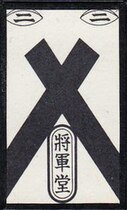| Batons | |
|---|---|
| Symbol from Trentine pattern | |
| Native names |
|
| Decks | |
| Invented | 15th century |

Batons or clubs is one of the four suits of playing cards in the standard Latin deck along with the suits of cups, coins and swords. 'Batons' is the name usually given to the suit in Italian-suited cards where the symbols look like batons. 'Clubs' refers to the suit in Spanish-suited cards where the symbols look more like wooden clubs.
Contents
- Characteristics
- Gallery
- Spanish pattern
- Italian pattern
- Komatsufuda pattern
- Unsun karuta pattern
- Kabufuda pattern
- See also
- Notes and references
Before 1800, French cardmakers, who also made Spanish card games, called them cartes à bâtons. Symbol on Italian pattern cards: ![]() Symbol on Spanish pattern cards:
Symbol on Spanish pattern cards: ![]() Symbol on French Aluette (Spanish-)pattern cards:
Symbol on French Aluette (Spanish-)pattern cards: ![]()






































